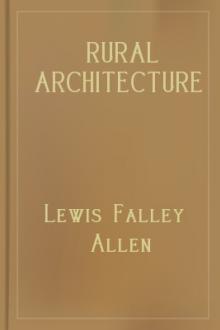Rural Architecture by Lewis Falley Allen (accelerated reader books .txt) 📖

- Author: Lewis Falley Allen
- Performer: -
Book online «Rural Architecture by Lewis Falley Allen (accelerated reader books .txt) 📖». Author Lewis Falley Allen
The great difficulty with many Americans in getting up a new place of any considerable extent is, that they seem to think whatever is common, or natural in the features of the spot must be so changed as to show, above all others, their own ingenuity and love of expense in fashioning it to their peculiar tastes. Rocks must be sunk, or blasted, trees felled, and bushes grubbed, crooked water-courses straightened—the place gibbeted and put into stocks; in fact, that their own boasted handiwork may rise superior to the wisdom of Him who fashioned it in his own good pleasure; forgetting that a thousand points of natural beauty upon the earth on which they breathe are
"When unadorned, adorned the most;"
and our eye has been frequently shocked at finding the choicest gems of nature sacrificed to a wanton display of expense in perverting, to the indulgence of a mistaken fancy, that, which, with an eye to truth and propriety, and at a trifling expense, might have become a spot of abiding interest and contentment.
(155)
(156) 
FARM HOUSE. Pages 155-156.
larger view
Design VI.A Southern or Plantation House.—The proprietor of a plantation in the South, or South-west, requires altogether a different kind of residence from the farmer of the Northern, or Middle States. He resides in the midst of his own principality, surrounded by a retinue of dependents and laborers, who dwell distant and apart from his own immediate family, although composing a community requiring his daily care and superintendence for a great share of his time. A portion of them are the attachés of his household, yet so disconnected in their domestic relations, as to require a separate accommodation, and yet be in immediate contiguity with it, and of course, an arrangement of living widely different from those who mingle in the same circle, and partake at the same board.
The usual plan of house-building at the South, we are aware, is to have detached servants' rooms, and offices, and a space of some yards of uncovered way intervene between the family rooms of the chief dwelling and its immediate dependents. Such arrangement, however, we consider both unnecessary and inconvenient; and we have devised a plan of household accommodation which will bring the family of the planter himself, and their servants, although under different roofs, into convenient proximity with each other. A design of this kind is here given.
The style is mainly Italian, plain, substantial, yet, we think, becoming. The broad veranda, stretching around three sides, including the front, gives an air of sheltered repose to what might otherwise appear an ambitious structure; and the connected apartments beyond, show a quiet utility which divests it of an over attempt at display. Nothing has been attempted for appearance, solely, beyond what is necessary and proper in the dwelling of a planter of good estate, who wants his domestic affairs well regulated, and his family, and servants duly provided with convenient accommodation. The form of the main dwelling is nearly square, upright, with two full stories, giving ample area of room and ventilation, together with that appropriate indulgence to ease which the enervating warmth of a southern climate renders necessary. The servants' apartments, and kitchen offices are so disposed, that while connected, to render them easy of access, they are sufficiently remote to shut off the familiarity of association which would render them obnoxious to the most fastidious—all, in fact, under one shelter, and within the readiest call. Such should be the construction of a planter's house in the United States, and such this design is intended to give.
A stable and carriage-house, in the same style, is near by, not connected to any part of the dwelling, as in the previous designs—with sufficient accommodation for coachman and grooms, and the number of saddle and carriage horses that may be required for either business or pleasure; and to it may be connected, in the rear, in the same style of building, or plainer, and less expensive, further conveniences for such domestic animals as may be required for family use.
The whole stands in open grounds, and may be separated from each other by enclosures, as convenience or fancy may direct.
The roofs of all the buildings are broad and sweeping, well protecting the walls from storm and frosts, as well as the glaring influences of the sun, and combining that comfortable idea of shelter and repose so grateful in a well-conditioned country house. It is true, that the dwelling might be more extensive in room, and the purposes of luxury enlarged; but the planter on five hundred, or five thousand acres of land can here be sufficiently accommodated in all the reasonable indulgences of family enjoyment, and a liberal, even an elegant and prolonged hospitality, to which he is so generally inclined.
The chimneys of this house, different from those in the previous designs, are placed next the outer walls, thus giving more space to the interior, and not being required, as in the others, to promote additional warmth than their fireplaces will give, to the rooms. A deck on the roof affords a pleasant look-out for the family from its top, guarded by a parapet, and giving a finish to its architectural appearance, and yet making no ambitious attempt at expensive ornament. It is, in fact, a plain, substantial, respectable mansion for a gentleman of good estate, and nothing beyond it.

GROUND PLAN.
INTERIOR ARRANGEMENT.This house stands 50×40 feet on the ground. The front door opens from the veranda into a hall, 24×14 feet, in which is a flight of stairs leading to the chambers above. On the left a door leads into a library, or business room, 17×17 feet, lighted by three windows. A fireplace is inserted in the outer wall. Another door leads into a side hall, six feet wide, which separates the library from the dining-room, which is also 17×17 feet in area, lighted and accommodated with a fireplace like the other, with a door leading into it from the side hall, and another door at the further right hand corner leading into the rear hall, or entry.
On the right of the chief entrance hall, opposite the library, a door opens into the parlor or drawing-room, 23×19 feet in area, lighted by three windows, and having a fireplace in the side wall. A door leads from the rear side of the parlor into a commodious nursery, or family bedroom, 19×16 feet in size, lighted by a window in each outer wall. A fireplace is also inserted on the same line as in the parlor. From the nursery a door leads into and through a large closet, 9×7 feet, into the rear hall. This closet may also be used as a sleeping-room for the children, or a confidential servant-maid, or nurse, or devoted to the storage of bed-linen for family use. Further on, adjoining, is another closet, 7×6 feet, opening from the rear hall, and lighted by a window.
Leading from the outer door of the rear hall is a covered passage six feet wide, 16 feet long, and one and a half stories high, leading to the kitchen offices, and lighted by a window on the left, with a door opening in the same side beyond, on to the side front of the establishment. On the right, opposite, a door leads on to the kitchen porch, which is six feet wide, passing on to the bath-room and water-closet, in the far rear. At the end of the connecting passage from the main dwelling, a door opens into the kitchen, which is 24×18 feet in size, accommodated with two windows looking on to the porch just described. At one end is an open fireplace with a cooking range on one side, and an oven on the other. At the left of the entrance door is a large, commodious store-room and pantry, 12×9 feet, lighted by a window; and adjoining it, (and may be connected with it by a door, if necessary,) a kitchen closet of the same size, also connected by a corresponding door from the opposite corner of the kitchen. Between these doors is a flight of stairs leading to the sleeping-rooms above, and a cellar passage beneath them. In the farther right corner of the kitchen a door leads into a smaller closet, 8×6 feet, lighted by a small window looking on to the rear porch at the end. A door at the rear of the kitchen leads out into the porch of the wash-room beyond, which is six feet wide, and another door into the wash-room itself, which is 20×16 feet, and furnished with a chimney and boilers. A window looks out on the extreme right hand, and two windows on to the porch in front. A door opens from its rear wall into the wood-house, 32×12 feet, which stands open on two sides, supported by posts, and under the extended roof of the wash-room and its porch just mentioned. A servants' water-closet is attached to the extreme right corner of the wood-house, by way of lean-to.
The bath-room is 10×6 feet in area, and supplied with water from the kitchen boilers adjoining. The water-closet beyond is 6 feet square, and architecturally, in its roof, may be made a fitting termination to that of the porch leading to it.


CHAMBER PLAN.
The main flight of stairs in the entrance hall leads on to a broad landing in the spacious upper hall, from which doors pass into the several chambers, which may be duly accommodated with closets. The passage connecting with the upper story of the servants' offices, opens from the rear section of this upper hall, and by the flight of rear stairs communicates with the kitchen and out-buildings. A garret flight of steps may be made in the rear section of the main upper hall, by which that apartment may be reached, and the upper deck of the roof ascended.
The sleeping-rooms of the kitchen may be divided off as convenience may dictate, and the entire structure thus appropriated to every accommodation which a well-regulated family need require.
The carriage-house is 48×24 feet in size, with a projection of five feet on the entrance front, the door of which leads both into the carriage-room and stables. On the right is a bedroom, 10×8 feet, for the grooms, lighted by a window; and beyond are six stalls for horses, with a window in the rear wall beyond them. A flight of stairs leads to the hayloft above. In the rear of the carriage-room is a harness-room, 12×4 feet, and a granary of the same size, each lighted by a window. If farther attachments be required for the accommodation of out-building conveniences, they may be continued indefinitely in the rear.

CARRIAGE HOUSE.
It may strike





Comments (0)